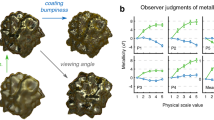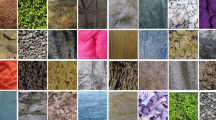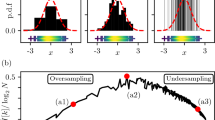Abstract
The world is full of surfaces, and by looking at them we can judge their material qualities. Properties such as colour or glossiness can help us decide whether a pancake is cooked, or a patch of pavement is icy. Most studies of surface appearance have emphasized textureless matte surfaces1,2,3, but real-world surfaces, which may have gloss and complex mesostructure, are now receiving increased attention4,5,6,7. Their appearance results from a complex interplay of illumination, reflectance and surface geometry, which are difficult to tease apart given an image. If there were simple image statistics that were diagnostic of surface properties it would be sensible to use them8,9,10,11. Here we show that the skewness of the luminance histogram and the skewness of sub-band filter outputs are correlated with surface gloss and inversely correlated with surface albedo (diffuse reflectance). We find evidence that human observers use skewness, or a similar measure of histogram asymmetry, in making judgements about surfaces. When the image of a surface has positively skewed statistics, it tends to appear darker and glossier than a similar surface with lower skewness, and this is true whether the skewness is inherent to the original image or is introduced by digital manipulation. We also find a visual after-effect based on skewness: adaptation to patterns with skewed statistics can alter the apparent lightness and glossiness of surfaces that are subsequently viewed. We suggest that there are neural mechanisms sensitive to skewed statistics, and that their outputs can be used in estimating surface properties.
This is a preview of subscription content, access via your institution
Access options
Subscribe to this journal
Receive 51 print issues and online access
$199.00 per year
only $3.90 per issue
Buy this article
- Purchase on Springer Link
- Instant access to full article PDF
Prices may be subject to local taxes which are calculated during checkout




Similar content being viewed by others
References
Land, E. H. & McCann, J. J. Lightness and retinex theory. J. Opt. Soc. Am. 61, 1–11 (1971)
Gilchrist, A. et al. An anchoring theory of lightness perception. Psych. Rev. 106, 795–834 (1999)
Brainard, D. H. Color constancy in the nearly natural image. 2. Achromatic loci. J. Opt. Soc. Am. A 15, 307–325 (1998)
Dana, K. J. et al. Reflectance and texture of real-world surfaces. ACM Trans. Graph. 18, 1–34 (1999)
Todd, J. T., Norman, J. F. & Mingolla, E. Lightness constancy in the presence of specular highlights. Psych. Sci. 15, 33–39 (2004)
Pont, S. C. & Koenderink, J. J. Bidirectional texture contrast function. Int. J. Comp. Vis. 62, 17–34 (2005)
Robilotto, R. & Zaidi, Q. Lightness identification of patterned three-dimensional, real objects. J. Vis. 6, 18–36 (2006)
Nishida, S. & Shinya, M. Use of image-based information in judgments of surface-reflectance properties. J. Opt. Soc. Am. A 15, 2951–2965 (1998)
Fleming, R. W., Dror, R. O. & Adelson, E. H. Real-world illumination and the perception of surface reflectance properties. J. Vis. 3, 347–368 (2003)
Dror, R. O., Willsky, A. S. & Adelson, E. H. Statistical characterization of real-world illumination. J. Vis. 4, 821–837 (2004)
Fleming, R. W. & Bülthoff, H. H. Low-level image cues in the perception of translucent materials. ACM Trans. Appl. Percept. 2, 346–382 (2005)
Levoy, M. et al. The Digital Michelangelo Project. 〈http://graphics.stanford.edu/projects/mich〉 (2004)
Nicodemus, F. Directional reflectance and emissivity of an opaque surface. Appl. Opt. 4, 767–773 (1965)
MacGillivray, H. L. Skewness and asymmetry: measures and orderings. Ann. Stat. 14, 994–1011 (1986)
Heeger, D. J. Modeling simple-cell direction selectivity with normalized, half-squared, linear operators. J. Neurophysiol. 70, 1885–1898 (1993)
Schiller, P. H., Finlay, B. L. & Volman, S. F. Quantitative studies of single-cell properties in monkey striate cortex. I. Spatiotemporal organization of receptive fields. J. Neurophysiol. 39, 1288–1319 (1976)
Baizer, J. S., Robinson, D. L. & Dow, B. M. Visual responses of area 18 neurons in awake, behaving monkey. J. Neurophysiol. 40, 1024–1037 (1977)
Shipp, S. & Zeki, S. The functional organization of area V2, I: specialization across stripes and layers. Vis. Neurosci. 19, 187–210 (2002)
Kagan, I., Gur, M. & Snodderly, D. M. Spatial organization of receptive fields of V1 neurons of alert monkeys: comparison with responses to gratings. J. Neurophysiol. 88, 2257–2274 (2002)
Mata, M. L. & Ringach, D. L. Spatial overlap of ON and OFF subregions and its relation to response modulation ratio in macaque primary visual cortex. J. Neurophysiol. 93, 919–928 (2005)
Malik, J. & Perona, P. Preattentive texture discrimination with early vision mechanisms. J. Opt. Soc. Am. A 5, 923–932 (1990)
Chubb, C., Landy, M. S. & Econopouly, J. A visual mechanism tuned to black. Vision Res. 44, 3223–3232 (2004)
Olshausen, B. A. & Field, D. J. Emergence of simple-cell receptive field properties by learning a sparse code for natural images. Nature 381, 607–609 (1996)
Simoncelli, E. P. & Olshausen, B. A. Natural image statistics and neural representation. Annu. Rev. Neurosci. 24, 1193–1216 (2001)
Kingdom, F. A. A., Hayes, A. & Field, D. J. Sensitivity to contrast histogram differences in synthetic wavelet-textures. Vision Res. 41, 585–598 (2001)
Acknowledgements
We thank Y. Li for discussions. L.S. and E.H.A. were supported by NTT and by a grant from the National Science Foundation to E.H.A.
Author information
Authors and Affiliations
Corresponding author
Ethics declarations
Competing interests
Reprints and permissions information is available at www.nature.com/reprints. The authors declare no competing financial interests.
Supplementary information
Supplementary Information 1
This file contains Supplementary Figure 1 which is a schematic of the main finding of the study, Supplementary Methods, Supplementary Video Legend which describes how to play the aftereffects demo movies, the Supplementary Data which is divided into four sections titled A through D, and the Supplementary Discussion. Supplementary Data A along with Supplementary Figures 2–4 describe the results for perceived lightness and glossiness for 42 natural surface images. Supplementary Data B and Supplementary Figures 5–8 compare the effects of various image statistics on lightness and glossiness perception. Supplementary Data C and Supplementary Figures 9 and 10 describe the effect of randomizing spatial structures in the image of a surface. Supplementary Data D and Supplementary Figures 11 and 12 contrast the effects of luminance skewness and subband skewness on the perceived lightness and glossiness. Supplementary Discussion and Supplementary Figures 13 and 14 describe the details of the proposed skewness detection mechanism. (PDF 1227 kb)
Supplementary Video 1
This file contains Supplementary Video 1 ‘stucco1’. For further information about the movie please see page 6 of the main Supplementary Information document. (MOV 1348 kb)
Supplementary Video 2
This file contains Supplementary Video 2 ‘stucco2’. For further information about the movie please see page 6 of the main Supplementary Information document. (MOV 1348 kb)
Supplementary Video 3
This file contains Supplementary Video 3 ‘texture1’. For further information about the movie please see page 6 of the main Supplementary Information document. (MOV 1319 kb)
Supplementary Video 4
This file contains Supplementary Video 4 ‘texture 2’. For further information about the movie please see page 6 of the main Supplementary Information document. (MOV 1320 kb)
Rights and permissions
About this article
Cite this article
Motoyoshi, I., Nishida, S., Sharan, L. et al. Image statistics and the perception of surface qualities. Nature 447, 206–209 (2007). https://doi.org/10.1038/nature05724
Received:
Accepted:
Published:
Issue Date:
DOI: https://doi.org/10.1038/nature05724
This article is cited by
-
Trypophobia, skin disease, and the visual discomfort of natural textures
Scientific Reports (2024)
-
Investigating the relationship between strawberry maturity and glossiness on the surface during storage through digital image analysis
Journal of Food Measurement and Characterization (2024)
-
Perceiving the representative surface color of real-world materials
Scientific Reports (2023)
-
Differential expansion speeds of Indo-Pacific warm pool and deep convection favoring pool under greenhouse warming
npj Climate and Atmospheric Science (2022)
-
Ensemble perception without phenomenal awareness of elements
Scientific Reports (2022)
Comments
By submitting a comment you agree to abide by our Terms and Community Guidelines. If you find something abusive or that does not comply with our terms or guidelines please flag it as inappropriate.



